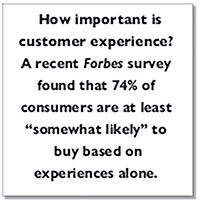Unlocking Success: Customer Experience Strategy Essentials
Darlene Compagna
Direct Opinions
While most companies are continuing to make investments in attracting and retaining customers, they aren’t necessarily building a coherent customer strategy. However, in today’s fast-paced and competitive landscape, providing a great customer experience can make all the difference in your business success. Based on a recent study by Forbes, 74% of consumers are at least “somewhat likely” to buy based on experiences alone. Because of this, customers won’t be choosing a company simply based on product or price. Their choices will be based on their entire customer experience.
 But providing a great customer experience doesn’t happen by accident. The process takes planning and preparation to deliver a positive, meaningful experience across all touchpoints between your customers and your business. Implementing a customer experience strategy can provide your team with the structure it needs to consistently deliver high-quality experiences that help you stand out in your market and grow your business.
But providing a great customer experience doesn’t happen by accident. The process takes planning and preparation to deliver a positive, meaningful experience across all touchpoints between your customers and your business. Implementing a customer experience strategy can provide your team with the structure it needs to consistently deliver high-quality experiences that help you stand out in your market and grow your business.
A McKinsey & Company report found businesses that implemented a company-wide customer experience program saw 15 to 20% increases in sales conversion rates, 20 to 50% declines in service costs, and 10 to 20% improvement in customer satisfaction. So, investing in providing a great customer experience is a guaranteed way to improve brand reputation, increase your bottom line and help streamline extra business costs.
Great customer experience is focused on ensuring all interactions and touchpoints with your business are easy, enjoyable, and seamless. The customer experience strategy defines the actionable plans in place to deliver a positive, meaningful experience across all interactions. The strategy is integrated across the business, coordinating different functions of product delivery and services.
Here’s how to create an effective customer experience strategy…
Define Your Customer Experience Vision
Your customer experience strategy flows from your brand strategy and incorporates the company’s personality and values. It defines not just what your company will deliver to customers, but also when, where, how, and why. This vision should align with your brand promises used in sales and marketing messaging.
Evaluate Your Current State
Understand how your customers currently interact with your company and identify what’s working and what’s not. Make sure to include team members from all departments. This will ensure buy-in and alignment around the goal of improving the overall customer experience and strengthening relationships.
Determine Your Customers’ Expectations…
Customer expectations are what people assume they will receive from your business. Gathering customer feedback will help you identify what your customers’ expectations are, but also how you are performing against those expectations. Identifying, then proactively managing customer expectations helps you stay one step ahead. When customers know exactly what to expect from a company, it becomes easier for the business to deliver on its promises.
Fill in the Gaps to Create a Seamless Experience
Once you understand where the current customer experience falls short, you can start to develop and implement solutions to better meet customer expectations. The right solutions will depend on what is negatively impacting experiences. Once you know where to improve, you can train your staff accordingly.
Create a Customer Journey Map
A customer journey map outlines all the interactions between a customer and your business. Utilize customer feedback and work with your team to create a journey map. Brainstorm ideas to reduce friction and improve business processes to deliver an experience that exceeds customer expectations.
Develop Metrics for Monitoring Progress
Establish clearly defined metrics to measure performance and a framework within the company to manage opportunities for improvement. Such metrics might include timeliness to schedule an appointment, and response time to inquiries or bids. Customer experience metrics can be used to gauge the improvements you make over time.
Everything you do impacts your customers’ perception of your business and their decision to buy from you or not. Your goal as a business owner should be to manage your customer experience strategy and work to continually improve it. This experience strategy development will keep the focus on the customer but will ultimately benefit your business. Positive experiences mean less friction with customers, a smoother operation and increased customer loyalty. It also aligns everyone on your team into a collective approach to delivering on your brand promises.
Consider these Customer Acceleration® tips that will help you make more money from your customers and make them happier in the process!
If you’d like some help to get started, please reach out to Darlene Campagna at dcampagna@directopinions.com or call 216-867-1165.